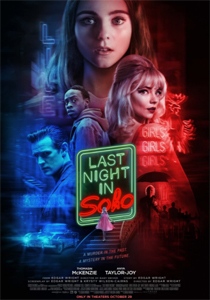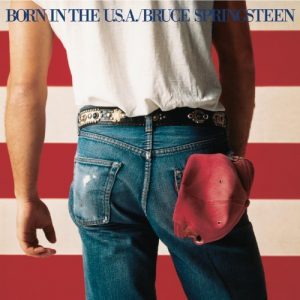Every frame of “Last Night in Soho” (2021) looks neon-gorgeous in a way reminiscent of “Blade Runner.” When London fashion student Ellie (Thomasin McKenzie) moves into an old second-story apartment, she finds it’s next to a bistro with alternating red, white and blue lights on its sign.
Visual masterpiece
It’s no surprise that Ellie’s sleep becomes more fitful than Kramer’s after Kenny Rogers’ Chicken opens. But for a viewer, those lights introduce a world of style.
For people who find “Blade Runner” boring, “Soho” is not that. While I noticed director/co-writer Edgar Wright’s lavish artistic victories throughout the film, I was also caught up in the story. And for people who find comparisons to “Blade Runner” overly generous, “Soho” is not as thematically deep.
“Last Night in Soho” (2021)
Director: Edgar Wright
Writers: Edgar Wright (story and screenplay), Krysty Wilson-Cairns (screenplay)
Stars: Thomasin McKenzie, Anya Taylor-Joy, Matt Smith
Yet I suspect it might gain status with time and be studied in film classes. Some connections are easy and fun to make: The bistro’s signage calls to mind police flashers, suggesting what the film will become.
Wright and co-writer Krysty Wilson-Cairns pen an exquisite genre mashup – part thriller, part mystery and ultimately horror — arguably of the B-grade variety, which will be off-putting to viewers who came for something classier. I’m inclined to forgive some typical beats, though, because “Soho” is so luscious and well-acted.
McKenzie (“Old”) and Anya Taylor-Joy (“The Queen’s Gambit”) can serve as porcelain pieces of art on screen. Wright uses them as models that are necessary to tell the story, yet they also happen to be great actresses.
Coming of age(s)
Ellie’s story is familiar: first big-city experience, first rent-paying job, first boyfriend (Michael Ajao as the likable John). She’s an English countryside girl who makes her own clothes – out of newspapers if she can’t afford fabric. (See, print isn’t dead yet.) When her dorm-mate says “I’m sorry,” it’s not because she didn’t hear Ellie’s answer about where she’s from. It’s because she’s sorry.
McKenzie makes this fresh again because she’s so fragile (at first glance). And also, Ellie herself is not normal. Her room back at her grandmother’s house is all Sixties except for an electric alarm clock. So the old upstairs flat, with its radiator and land line, seems a better fit than the party-central dorm.
It’s tempting for a nostalgic person to decorate their place like their favorite era; notice the rise of Eighties kids decorating their basements to look like Blockbuster Video stores. But Ellie does have that clock, plus a smartphone. I’d add a modern TV … and streaming services … oh, and a laptop and internet connection for blogging …
Well, living in the past is a nice idea, anyway. But when Ellie dreams about the Sixties, things turn engagingly weird, then weirdly mysterious, then mysteriously creepy. Like a ghost, she follows alongside Taylor-Joy’s Sandie, who looks to make it big as a stage singer in debauchery-laden Soho.
Same but different
When Ellie dresses and styles her hair like Sandie, it becomes harder for us to tell them apart, which is the point. Their voices are very different, but both actresses are big-eyed with unorthodox beauty.
The superficial similarity of Ellie and Sandie is Wright’s grand thematic misdirection. “Soho” isn’t about sameness, but rather contradictions. It explores how paranoia grows from truth, but leaves truth in the dust, resulting in insanity. It goes to crazy places, but it’s impressive how easy it is to go crazy. Based on what she’s experiencing, never does Ellie make a ridiculous step.
The score and soundtrack smoothly change along with the genres and events. I love the use of James Ray’s 1961 song “I’ve Got My Mind Set on You.” George Harrison’s Eighties version is a cover, but it’s much more popular, so Ray’s will seem like a cover to many viewers.
OK, maybe I’m covering for my embarrassment of just now learning about Ray’s version. But it fits with how “Soho’s” narrative moves forward when Ellie goes backward.
Wright explores the Sixties through neon-colored glasses, but he also shows how Soho’s crime-ridden streets aren’t so great up close.
In fact, the least beautiful part of the movie comes in the closing credits, when we see bland, present-day snapshots of the neighborhood. There’s nothing visually striking about Soho … in reality. Fortunately, “Last Night in Soho” takes us a mesmerizing half-step beyond.


